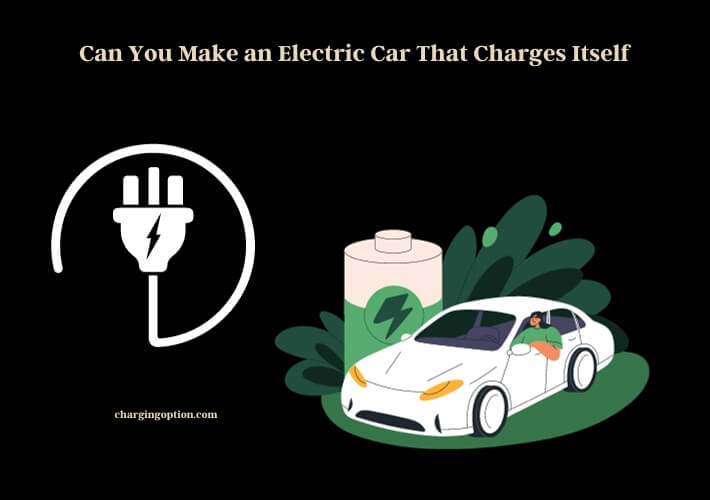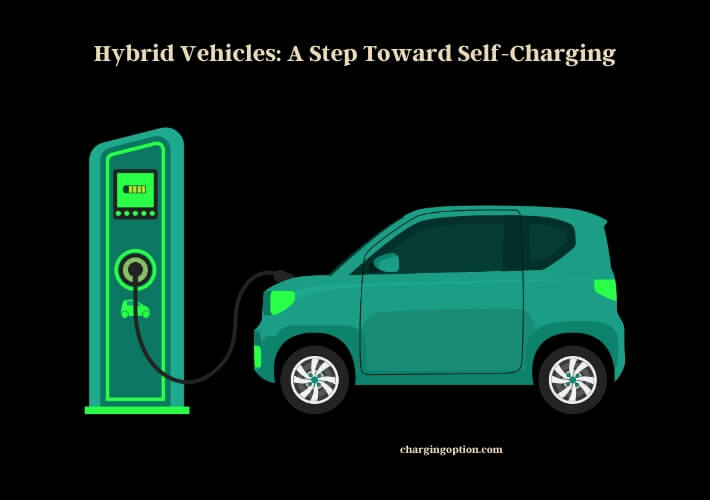Yes, there are methods for electric cars to regain some energy during operation. No, a fully self-charging electric car isn’t a reality yet.
Electric vehicles (EVs) have made significant strides in recent years, with advancements in technology and design. One of the intriguing concepts surrounding EVs is the idea of self-charging. While some electric cars can recuperate energy through regenerative braking, this doesn’t equate to a car that charges itself entirely. Regenerative braking allows the vehicle to recover some of the energy lost during deceleration, converting it back into electricity for the battery.
The notion of electric cars charging themselves with an alternator, similar to traditional vehicles, faces challenges. Alternators in conventional cars replenish the 12-volt battery, not to propel the vehicle. In EVs, the energy required to move the car is much greater, making this method inefficient.

As for the idea of electric cars charging themselves with solar panels, while some prototypes exist, the energy generated is not sufficient for long drives. Solar panels on cars can support auxiliary functions but not the primary propulsion.
Hybrid vehicles, which combine gasoline engines with electric motors, have mechanisms to charge their batteries, but they rely on fuel. The concept of charging an electric car with a generator while driving presents safety and efficiency concerns.
In 2023, the dream of a fully self-charging electric car remains elusive. While there are methods to regain some energy, the technology for a car that can fully charge itself during regular operation is still in development.
Can Electric Cars Truly Charge Themselves? An In-depth Analysis
The Concept of Self-Charging Electric Cars
What does self-charging mean in the context of electric vehicles?
In the world of electric cars, the term self-charging is akin to a golden fleece—a highly sought-after feature that could revolutionize the industry. Imagine a car that replenishes its own battery, reducing or even eliminating the need for stops at the charging station. It sounds like something from a sci-fi movie, doesn’t it? Yet, it’s a concept that engineers and innovators are tirelessly working to make a reality.
The difference between regenerative energy and self-charging
Regenerative energy and self-charging are often used interchangeably, but they’re not twins, more like distant cousins. Regenerative energy, especially in the form of braking, is about capturing the energy usually lost during deceleration and feeding it back to the battery. Self-charging, on the other hand, is the ambitious dream of a car that can fully recharge its own battery, making charging stations a relic of the past.
Current Technologies Supporting Partial Self-Charging
Regenerative braking: How it works and its limitations
Regenerative braking is like a sneak peek into the future. When you hit the brakes, instead of all that energy turning into heat and going to waste, it’s captured and stored back in the battery. Neat, right? But it’s not a magic wand. It can’t fully charge the battery; it just gives it a little top-up, extending the car’s range but not eliminating the need for a good old-fashioned charge now and then.
Solar panels on vehicles: Potential and challenges
Solar panels on cars sound like a match made in heaven. Harnessing the power of the sun to drive our vehicles? Brilliant! But it’s not all sunshine and rainbows. The energy generated is often only enough to power auxiliary functions like air conditioning or the radio. So, while it’s a step in the right direction, we’re not quite at the point where a sunny day means a full battery.
The Alternator Question
Role of alternators in traditional vehicles
Alternators in gas-powered cars have a pretty straightforward job: keep the battery charged and power the electrical system. It’s like having a mini power station under the hood. But can this technology be the knight in shining armor for electric vehicles? Let’s find out.
Why alternators aren’t the solution for EVs
Here’s the catch – alternators are great for a 12-volt battery but, an electric car needs a whole lot more juice to keep rolling. It’s like trying to fill a swimming pool with a garden hose – it’s just not practical. So, while the trusty alternator is a star player in traditional vehicles, it’s sitting on the bench in the game of electric cars.
Hybrid Vehicles: A Step Toward Self-Charging?

Basics of hybrid vehicle technology
Hybrids are like the middle child, borrowing traits from both gas-powered and electric siblings. They have a gas engine and an electric motor, each picking up the slack where the other falls short. It’s a team effort that makes hybrids versatile and efficient.
How hybrids charge their batteries and the role of fuel
But are they self-charging? Well, not exactly. They’re more like self-sustaining. The gas engine helps charge the battery, but it still needs fuel. It’s like having a backup generator; handy, but still dependent on being fed a steady diet of gasoline.
Challenges in Creating Fully Self-Charging Electric Cars
Energy requirements for propulsion vs. auxiliary functions
Electric cars need a lot of energy to keep them moving, way more than just powering the lights and air conditioning. It’s like comparing the energy it takes to jog around the block with running a marathon. So, the big question is, can we create a battery that self-charges while also meeting the car’s energy needs?
Safety concerns and efficiency issues
And let’s not forget about safety. Playing with electricity is no joke. Ensuring that self-charging mechanisms are safe, reliable, and efficient is a tall order. It’s like juggling flaming swords – impressive if done right, but there’s a lot that can go wrong.
Innovations on the Horizon: What 2023 and Beyond Holds
Prototypes and experimental models in the market
Every year, we see new kids on the block – prototypes and experimental models that promise to bring us closer to the dream of self-charging electric cars. They’re like glimpses into a future where range anxiety is a thing of the past. But how close are we, really?
Research and development in the realm of self-charging technology
The R&D labs are buzzing, innovations are popping up like spring flowers, and every breakthrough brings us a step closer. It’s a journey, not a sprint. Each discovery, each advancement, is a piece of the puzzle. Who knows what tomorrow holds?
Comparing Self-Charging Mechanisms with Traditional Charging
Speed, efficiency, and practicality of charging methods
In the race between traditional and self-charging methods, who takes the trophy? Traditional charging is like the reliable friend who’s always there when you need them. But self-charging? That’s the elusive, exciting enigma we’re all eager to meet.
Environmental and economic implications
And it’s not just about convenience. It’s a dance between reducing emissions, conserving energy, and making it all affordable. Can self-charging cars be the golden ticket to a cleaner, greener world without breaking the bank?
Is the Popping Noise While Charging Related to a Self-Charging Mechanism in Electric Cars?
Many Tesla owners have reported a peculiar “popping” noise while charging their electric cars. Some speculate that it may be related to a self-charging mechanism in Tesla vehicles. However, Tesla has not officially addressed this issue, leaving owners searching for answers about the mysterious Tesla charging popping noise.
The Future of Electric Vehicles and Charging Infrastructure
The role of charging stations and their evolution
Charging stations are popping up like mushrooms after the rain. But if cars start charging themselves, what happens to these electric oases? Will they go the way of the payphone, or evolve into something new and exciting?
How self-charging fits into the broader EV ecosystem
Self-charging isn’t just about the cars. It’s a piece in the intricate jigsaw puzzle of the electric vehicle ecosystem. Every piece, from the cars to the charging infrastructure, to the energy sources, has to fit perfectly. Are we ready for the transformation?
The journey of electric vehicles is akin to a thrilling novel, with each chapter unveiling new possibilities. From the dream of self-charging to the realities of today’s technology, the narrative is ever-evolving. As we cruise through 2023 and beyond, one thing is clear: the road ahead is electrifying, with twists and turns waiting to surprise us. So, buckle up and enjoy the ride!
